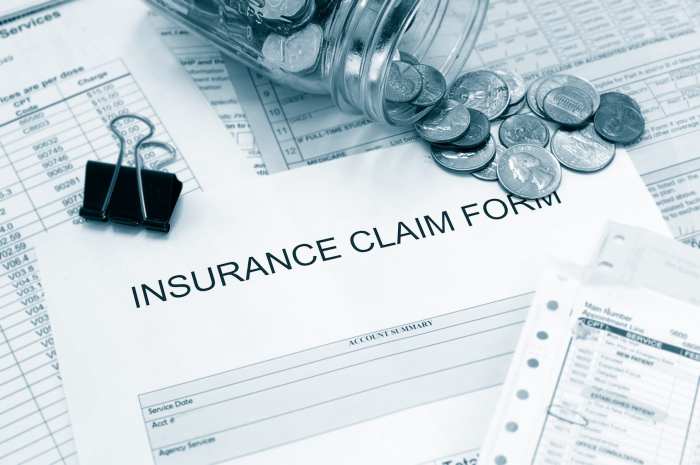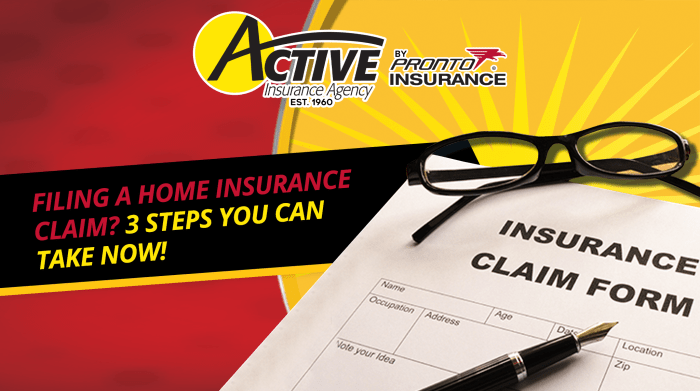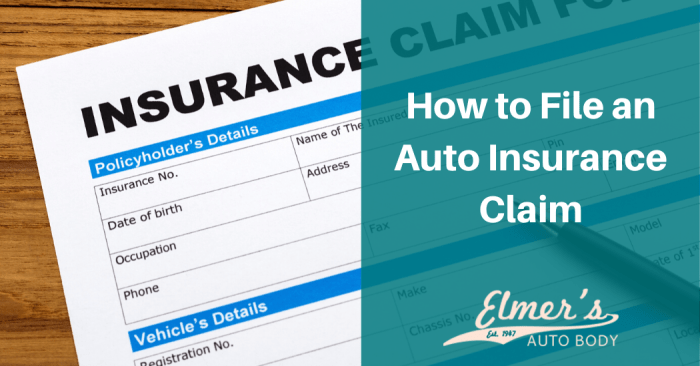How do I file a claim for auto and home insurance? This question pops up when the unexpected happens, leaving you scrambling to navigate the process. Whether it’s a fender bender or a leaky roof, understanding your policy and knowing how to file a claim can save you time and stress.
This guide will walk you through the entire process, from reporting the incident to negotiating a settlement, so you can feel confident in handling your insurance claim.
From the initial shock of an accident or disaster to the eventual resolution of your claim, navigating the insurance world can be overwhelming. But, with a clear understanding of the process and the right information, you can streamline the process and get back on your feet faster.
Understanding Your Insurance Policy

Knowing the ins and outs of your insurance policy is crucial when filing a claim. It helps you understand what’s covered, what’s not, and what steps you need to take.
Types of Coverage in Auto and Home Insurance Policies
Auto and home insurance policies typically include a range of coverage options. Understanding these can help you determine what you need and how much coverage is right for you.
- Liability Coverage:This is the most basic type of coverage, protecting you financially if you’re responsible for an accident that causes damage to another person’s property or injuries. It covers medical expenses, property damage, and legal defense costs.
- Collision Coverage:This coverage pays for repairs or replacement of your vehicle if it’s damaged in an accident, regardless of who’s at fault. It covers damage from collisions with other vehicles, objects, or even hitting a deer.
- Comprehensive Coverage:This coverage protects your vehicle from damage caused by non-collision events like theft, vandalism, fire, hail, or natural disasters. It also covers damage from hitting an animal.
- Uninsured/Underinsured Motorist Coverage:This coverage protects you if you’re hit by a driver who doesn’t have insurance or doesn’t have enough coverage to cover your losses. It helps pay for medical expenses and property damage.
- Personal Injury Protection (PIP):This coverage, also known as “no-fault” coverage, pays for your medical expenses and lost wages regardless of who caused the accident. It’s usually required in some states.
- Dwelling Coverage:For homeowners insurance, this coverage protects the structure of your home from damage caused by fire, windstorms, hail, and other perils. It covers the cost of repairs or rebuilding.
- Personal Property Coverage:This coverage protects your belongings inside your home, like furniture, electronics, clothing, and jewelry, from damage or loss caused by covered perils. It typically includes coverage for theft and vandalism.
- Liability Coverage:This coverage protects you from financial losses if someone is injured on your property or you’re found liable for damage to someone else’s property.
- Medical Payments Coverage:This coverage pays for medical expenses for you and your family members, regardless of who caused the accident, if you’re injured in an accident on your property.
- Loss of Use Coverage:This coverage helps pay for temporary living expenses if your home is uninhabitable due to a covered event. It can cover hotel stays, meals, and other necessities.
Common Exclusions and Limitations
It’s important to be aware of what your policy doesn’t cover. Insurance policies typically have exclusions and limitations that restrict coverage.
- Wear and Tear:Most policies don’t cover damage caused by normal wear and tear, like a worn-out tire or a cracked windshield due to age.
- Neglect or Intentional Acts:Damage caused by your own negligence or intentional acts is usually not covered. For example, if you leave your car unlocked and it’s stolen, your comprehensive coverage might not apply.
- Acts of War:Insurance policies typically exclude coverage for damage caused by war or terrorism.
- Certain Natural Disasters:Some policies may exclude coverage for damage caused by specific natural disasters like earthquakes or floods, depending on your location and the specific policy provisions.
- Specific Types of Property:Some policies may exclude coverage for certain types of property, like valuable collectibles or high-risk items. It’s essential to check your policy for specific exclusions.
- Deductibles:Deductibles are the amount you’re responsible for paying out of pocket before your insurance coverage kicks in. For example, if you have a $500 deductible for collision coverage, you’ll need to pay the first $500 of repair costs.
- Coverage Limits:Your policy will have limits on the maximum amount of coverage you can receive for different types of losses. For example, there might be a limit on the amount your policy will pay for property damage or medical expenses.
Locating Coverage Information in Your Policy
Your insurance policy is your contract with your insurance company, and it Artikels the terms of your coverage. It’s essential to read your policy carefully to understand what’s covered and what’s not.
- Policy Declarations Page:The declarations page is the first page of your policy and summarizes your coverage details, including your name, policy number, coverage amounts, deductibles, and effective dates. This page provides a quick overview of your policy’s key features.
- Coverage Sections:The policy will be divided into different sections, each covering a specific type of coverage, like liability, collision, comprehensive, or personal property. Read through each section to understand the details of your coverage for each type of loss.
- Exclusions and Limitations:Look for sections that list exclusions and limitations, which will detail what’s not covered under your policy. Pay close attention to these sections to avoid surprises when you file a claim.
- Claims Procedures:Your policy will include a section that Artikels the claims process, including how to report a claim, what documentation you’ll need, and the steps involved in getting your claim processed.
Reporting an Incident

Reporting an incident to your insurance company is the first step in the claims process. It’s important to do this promptly and accurately so your claim can be processed efficiently.
Reporting Methods
Here are some common ways to report an incident:
- Phone Call:This is the most traditional method. You can call your insurance company’s customer service line, usually available 24/7. This method allows for immediate assistance and clarification of any questions you may have.
- Online Forms:Many insurance companies offer online forms for reporting incidents. This can be a convenient option, allowing you to report the incident at your own pace and submit supporting documentation.
- Mobile App:Some insurance companies provide mobile apps that allow you to report incidents directly from your phone. This can be especially helpful for incidents that occur while you’re on the go.
Comparing Reporting Methods
| Method | Advantages | Disadvantages |
|---|---|---|
| Phone Call | Immediate assistance, allows for clarification of questions | May require longer wait times, limited documentation options |
| Online Forms | Convenient, allows for detailed documentation, accessible 24/7 | May require technical proficiency, potential for delays in processing |
| Mobile App | Convenient, accessible on the go, often includes photo/video upload | May have limited functionality compared to online forms, app compatibility issues |
Importance of Accurate Information, How do I file a claim for auto and home insurance?
Providing accurate and detailed information during the initial incident report is crucial. This information helps your insurance company:
- Assess your claim:Your insurance company needs to understand the details of the incident to determine if it’s covered by your policy and to calculate the amount of coverage you’re eligible for.
- Investigate the incident:Your insurance company may need to investigate the incident to determine the cause and liability.
- Process your claim:Accurate information ensures your claim is processed efficiently and without delays.
Gathering Necessary Documentation: How Do I File A Claim For Auto And Home Insurance?

You’ve reported the incident, now it’s time to gather the essential documentation to support your claim. This includes items that prove the damage, the cost of repairs, and any injuries sustained.
Documentation Required for Filing a Claim
Having the right documents ensures a smooth and efficient claims process.
- Police Report:If the incident involved an accident, theft, or vandalism, obtain a police report. This official document serves as proof of the incident and provides details like the date, time, location, and parties involved.
- Medical Records:If you or anyone else sustained injuries, gather medical records from doctors, hospitals, or other healthcare providers. These records document the extent of the injuries, treatment received, and associated costs.
- Repair Estimates:Obtain estimates from reputable repair shops or contractors for the cost of repairing or replacing damaged property. Multiple estimates are recommended to ensure fairness and accuracy.
- Photos and Videos:Visual documentation is crucial. Take clear, detailed photos and videos of the damage, including all angles and perspectives. Capture the surrounding environment to provide context. This evidence helps demonstrate the extent of the damage and supports your claim.
- Other Relevant Documents:Depending on the nature of the claim, you might need additional documents, such as receipts for lost or damaged items, contracts, or insurance policies.
Taking Clear and Comprehensive Photos
Photographs are essential for demonstrating the extent of the damage and supporting your claim.
- Capture All Angles:Take photos from different angles, including close-ups, wide shots, and overhead views. This provides a comprehensive picture of the damage.
- Focus on Details:Take photos of specific details, such as dents, scratches, broken parts, and water damage. These details help to accurately assess the extent of the damage.
- Use a Grid Pattern:To ensure consistency and completeness, use a grid pattern when taking photos. This involves taking photos of the entire area, then focusing on individual sections in a grid-like pattern.
- Include Reference Points:Include reference points in your photos, such as a ruler or a known object, to provide a sense of scale and perspective.
- Date and Time Stamp:Make sure your photos are date and time stamped. This provides evidence of when the photos were taken, which can be helpful in case of any disputes.
Preserving Evidence
It’s essential to preserve evidence related to your claim. This ensures a strong case and helps avoid delays or complications.
Preserve evidence to support your claim.
- Don’t Discard Damaged Items:Even if items are damaged beyond repair, avoid discarding them. Your insurance company might need to inspect them to assess the damage.
- Secure the Scene:If possible, secure the scene of the incident to prevent any further damage or tampering with evidence.
- Document Everything:Keep detailed records of all communications, interactions, and documentation related to your claim. This includes emails, phone calls, and meeting notes.
- Avoid Making Unnecessary Repairs:Avoid making repairs before your insurance company has had a chance to assess the damage. This can affect your claim and potentially lead to disputes.
Final Wrap-Up

Filing a claim for auto and home insurance doesn’t have to be a daunting task. By following these steps and understanding your policy, you can approach the process with confidence. Remember to document everything, communicate clearly, and don’t be afraid to ask questions.
With a little preparation and the right resources, you can successfully navigate the claims process and get the compensation you deserve.
FAQs
What if I can’t find my insurance policy?
Contact your insurance company directly. They can provide you with a copy of your policy or help you locate it.
What if I’m not sure if the damage is covered by my policy?
Call your insurance company and speak with a representative. They can help you determine if the damage is covered and explain your coverage options.
What if I disagree with the insurance company’s claim decision?
You have the right to appeal the decision. Your policy should Artikel the appeals process. Be sure to gather all relevant documentation to support your appeal.
How long does the claims process typically take?
The claims process can vary depending on the complexity of the claim and the insurance company. It can take a few weeks to a few months. However, you can often track the progress of your claim online or through your insurance company’s mobile app.
What if I have additional questions about the claims process?
Don’t hesitate to contact your insurance company’s customer service department. They are there to help you understand the process and answer any questions you may have.
